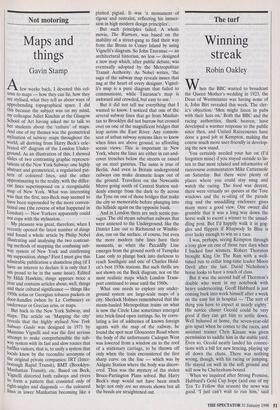Not motoring
Maps and things
Gavin Stamp
Afew weeks back, I devoted this col- umn to maps — how they can lie, how they are stylised, what they tell us about ways of apprehending topographical space. I did this because the subject was on my mind, my colleague Juliet Kinchin at the Glasgow School of Art having asked me to talk to her students about the 'culture' of maps. And one of my themes was the geometrical stylisation of subway maps throughout the world, all deriving from Harry Beck's cele- brated 45° diagram of the London Under- ground. As an illustration of this, I showed Slides of two contrasting graphic represen- tations of the New York Subway: one highly abstract and geometrical, a regularised pat- tern of coloured lines, and the other approximating to the reality, with the differ- ent lines superimposed on a recognisable map of New York. What was interesting was that the first, neo-Beck map seemed to have been superseded by the more conven- tional one (the reverse of what happened in London) — New Yorkers apparently could not cope with the stylisation.
My pleasure was great, therefore, when I recently opened the latest number of things and found a whole article by Philip Nobel illustrating and analysing the two contrast- lug methods of mapping the confusing sub- way system of New York and confirming my supposition. things? First I must give this admirable publication a shameless plug (if I have an interest to declare it is only that I am proud to be in the same issue). Edited by Hildi Hawkins, things appears twice a Year and contains articles about, well, things and their cultural significance — things like 1950s sofas or Georgian tobacco packets or door-handles (when by Le Corbusier) or underwear or Grecian urns, or maps.
But back to the New York Subway, and maps. The article on 'Mapping the city' reveals that the highly stylised New York Subway Guide was designed in 1971 by Massimo Vignelli and was the first serious attempt to make comprehensible the sub- way system with its fast and slow routes that baffles visitors, that is, to unify a system that locals knew by the recondite acronyms of the original private companies: IRT (Inter- borough Rapid Transit), BMT (Brooklyn- Manhattan Transit), etc. Based on Beck, Vignelli distorted both railways and rivers to form a pattern that consisted only of right-angles and diagonals — the coloured lutes in lower Manhattan becoming like a plaited pigtail. It was 'a monument of rigour and restraint, reflecting his immer- sion in high modern design principles'.
But such principles failed. A whole movie, The Warriors, was based on the inability of a street-gang to find their way from the Bronx to Coney Island by using Vignelli's diagram. So John Tauranac — an architectural historian, no less — designed a new map which, after public debate, was eventually adopted by the Metropolitan Transit Authority. As Nobel writes, 'the saga of the subway map reveals issues that nag at the heart of every designer. Vignel- li's map is a pure diagram that failed to communicate, while Tauranac's map is awkward and crowded, but easy to use.'
But it did not tell me everything that I wanted to know. I noticed that one of the several subway lines that go from Manhat- tan to Brooklyn did not burrow but crossed over on one of the magnificent bridges that leap across the East River. Any connois- seur of urban subway systems likes to know when lines are above ground, so affording scenic views. This is important in New York, where the lines are either in cut-and- cover trenches below the streets or raised up on steel gantries. The same is true of Berlin. And even in Britain underground railways can make dramatic leaps out of the ground. Travellers on the Newcastle Metro going south of Central Station sud- denly emerge from the dark to fly across the Tyne on one of those bridges that make the city so memorable before plunging into the hillside again on the opposite bank.
And in London there are such scenic pas- sages. The old steam suburban railways that were annexed to the Underground, like the District Line out to Richmond or Wimble- don, run on the surface, of course, but even the more modern tube lines have their moments, as when the Piccadilly Line emerges from the ground north of Turnpike Lane only to plunge back into darkness to reach Southgate and one of Charles Hold- en's best 1930s stations. But such thrills are not shown on the Beck diagram, nor on the most realistic maps which London Trans- port continued to issue until the 1960s.
What one needs to explore any under- ground system are large-scale maps of a city. Sherlock Holmes remembered that the steam-hauled Metropolitan trains on what is now the Circle Line sometimes emerged into brick-lined open cuttings. So, by corre- lating a list of addresses of known foreign agents with the map of the railway, he found the spot near Gloucester Road where the body of the unfortunate Cadogan West was lowered from a window on to the roof of a stationary carriage, to be thrown off only when the train encountered the first sharp curve on the line — which was by Aldgate Station where the body was discov- ered. Thus was the mystery of the stolen Bruce-Partington Plans solved. But Harry Beck's map would not have been much help: not only are no streets shown but all the bends are straightened out.


































































 Previous page
Previous page